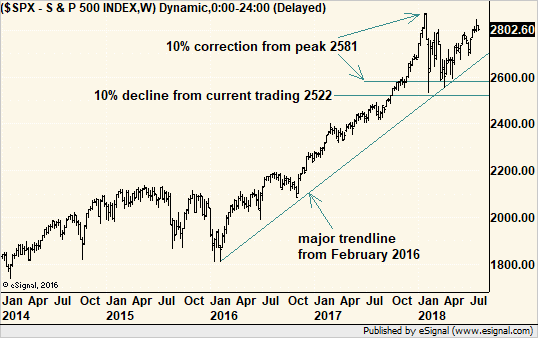Stumbling FANGs? No Problem, Says the Market
Tech leaders swooned in late July, but stocks just kept plodding along


The end of July was brutal for several big tech stocks that posted very visible earnings misses.
Facebook (FB) wasn’t the first company to disappoint, but it got the entire sector reeling when it plummeted 19% and suffered the biggest single-day loss in market value – a massive $119.1 billion. That’s more than the entire market value of Dow Jones Industrial Average component United Technologies (UTX).
The earnings problems continued, including Twitter’s (TWTR) 21% plunge despite beating analyst estimates on the top and bottom lines. User growth was the problem as the company purged itself of suspended and fake accounts.
From just $107.88 $24.99 for Kiplinger Personal Finance
Become a smarter, better informed investor. Subscribe from just $107.88 $24.99, plus get up to 4 Special Issues

Sign up for Kiplinger’s Free Newsletters
Profit and prosper with the best of expert advice on investing, taxes, retirement, personal finance and more - straight to your e-mail.
Profit and prosper with the best of expert advice - straight to your e-mail.
Just about all the FANGs – Facebook, Amazon.com (AMZN), Netflix (NFLX) and Google parent Alphabet (GOOGL), though Apple (AAPL) and Microsoft (MSFT) are frequently included in similar acronyms – fared poorly shortly after earnings.
However, the devastation was not really a surprise for some charting enthusiasts who use price action (and their derivatives) as their guide. No truth-telling technical analyst expected the giant haircut bestowed upon Facebook, but analysis of price momentum suggested that a selloff was in the offing.
A Momentum-Driven Market
There is no doubt that investors were quite enthusiastic about Big Tech as this group led the market higher for the past five years. Every small dip or pullback sparked fresh buying. Everybody, it seemed, needed to have several of these highflying stocks in their portfolio.
When groups of stocks lead in this way, their bullishness breeds more bullishness, no matter what their valuations may be. Pundits classify such a market as a “momentum market,” or momo, for short.
Momentum is the speed of a price advance. Most free charting software offers indicators to measure momentum, and they are quite useful to detect conditions when a rally gets a bit too exuberant.
They also can detect when momentum starts to wane long before a rising stock actually sells off. While they are from perfect, throughout July, the charts showed rising prices with falling momentum.
Think of a ball thrown up into the air. Even as it moves higher, its speed declines. Eventually, gravity overwhelms the power that propelled the ball in the first place and the ball finally starts to head back down.
Which FANG stocks showed such divergences between their price trends and momentum? All of them. So did other superstars, such as Adobe (ADBE), Nvidia (NVDA), Visa (V) and Intel (INTC).
The Death of Momo?
The question for investors must ask is, “Is momo dead?” Can they still buy every dip the market stingily offers? Or is it time to take some profits and maybe even step aside completely?
The reign of the FANGs seems to be in jeopardy. The naysayers who squawked about sky-high valuations and the market’s lack of regard for sound fundamentals finally saw some vindication as many of these leaders stumbled.
The problem is that their stocks just got into a bit of a frenzy that pushed prices up too high, too fast. However, for the most part, these companies still make money and continue to innovate.
The recent corrections in tech stocks were great examples of how the market will eventually clean itself up and allow investors to buy high-quality companies at more realistic prices. For sure, it took a long time to happen, and the selloff in some companies (Facebook) was brutal.
That’s the nature of the stock market. It tells us when it had enough, not the other way around.
The current turbulence seems different than previous declines because the selling followed bad earnings or outlook news, rather than quick bursts of market noise. It suggests the nature of the market changed from momo to something else. That’s not necessarily bearish, especially since most of the FANGs remain in rising, bullish trends – just look at Apple’s recent scoot to new highs and $1 trillion in market capitalization. However, blindly buying every dip may not be the right strategy anymore.
But Is the Broad Market Topping?
Just because momo seems to be over does not mean it is the end of the overall bull market. Far from it.
While unsatisfying for those looking for unabashed punditry, the Standard & Poor’s 500-stock index already suffered a 10.16% drop on a daily close basis, in January and February. That’s just above the arbitrary definition of a correction of 10%. But in July, the S&P 500 actually exited correction territory; theoretically, now it should be just a matter of time before the next leg up kicks in.
Look at the weekly chart below. The trend from early 2016 remains intact and rising. And for more advanced chart watchers, another 10% correction from current levels, should that happen, would create a rather substantial floor under the market.

But can the market fall even more than that and reach the also-arbitrary definition of a bear market with a 20% decline from the peak?
Anything is possible, but it seems quite unlikely right now.
After all, the rest of earnings season looks quite healthy, with 77% of companies beating second-quarter analysts estimates so far, according to StreetInsider.com. FactSet reported that earnings growth boomed, with the blended earnings growth rate for Q1 among S&P 500 companies at 23.2%, the highest result since Q3 2010.
Politics aside, the second-quarter GDP growth rate of 4.1% is undeniably good. Yes, it’s expected to slow from that point, but the economy still could grow at a lesser pace and still look strong.
People also feel better about the economy. The IBD/TIPP Economic Optimism Index is holding at levels not seen since 2005, when the housing bubble was still inflating.
Gold, the hedge against bad times, still languishes. If people were feeling nervous, the yellow metal “should” be a bit stronger because gold, silver and some hard assets outperform when fear swells. But amid optimism and actual economic growth, not to mention almost nonexistent inflation, there is no reason to flock to gold now.
Finally, interest rates are still quite low despite the Federal Reserve’s campaign to normalize them by pushing them higher. We could make the counter-argument that stubbornly low interest rates can mean that the bond market does not have confidence in the current economic recovery. But until there is corroboration for that conclusion, we must keep it on the shelf.
As for corroboration for the bullish argument for stocks, while technology stumbles, financials and health care appear to be emerging as leaders, at least for now. This is significant because leadership does move around from sector to sector in a healthy bull market. The term for that is “sector rotation.”
Tech currently represents 26% of the S&P 500’s value, so its loss from the leadership ranks could suggest problems for the broader market. However, health care, at just under 14.1%, and financials, at 13.8%, are the Nos. 2 and 3 sectors. Having them back in the lead is a positive development.
The conclusion? The market still is OK at this time. The potential for another 10% drop is real, but unless it makes a significantly lower low than we saw earlier in the year, the bull-market trend remains intact.
Profit and prosper with the best of Kiplinger's advice on investing, taxes, retirement, personal finance and much more. Delivered daily. Enter your email in the box and click Sign Me Up.

-
 What to Do If You Plan to Make Catch-Up Contributions in 2026
What to Do If You Plan to Make Catch-Up Contributions in 2026Under new rules, you may lose an up-front deduction but gain tax-free income once you retire.
-
 If You'd Put $1,000 Into Lowe's Stock 20 Years Ago, Here's What You'd Have Today
If You'd Put $1,000 Into Lowe's Stock 20 Years Ago, Here's What You'd Have TodayLowe's stock has delivered disappointing returns recently, but it's been a great holding for truly patient investors.
-
 How to Max Out Your 401(k) in 2026 (New Limits are Higher)
How to Max Out Your 401(k) in 2026 (New Limits are Higher)In 2026, the maximum contribution limits for 401(k) plans have increased, giving you an excellent shot at maximizing your retirement savings.
-
 If You'd Put $1,000 Into Lowe's Stock 20 Years Ago, Here's What You'd Have Today
If You'd Put $1,000 Into Lowe's Stock 20 Years Ago, Here's What You'd Have TodayLowe's stock has delivered disappointing returns recently, but it's been a great holding for truly patient investors.
-
 Stocks Extend Losing Streak After Fed Minutes: Stock Market Today
Stocks Extend Losing Streak After Fed Minutes: Stock Market TodayThe Santa Claus Rally is officially at risk after the S&P 500's third straight loss.
-
 If You'd Put $1,000 Into 3M Stock 20 Years Ago, Here's What You'd Have Today
If You'd Put $1,000 Into 3M Stock 20 Years Ago, Here's What You'd Have TodayMMM stock has been a pit of despair for truly long-term shareholders.
-
 Santa Claus Rally at Risk as Tech Stocks Slump: Stock Market Today
Santa Claus Rally at Risk as Tech Stocks Slump: Stock Market TodayThe Nasdaq Composite and Dow Jones Industrial Average led today's declines as investors took profits on high-flying tech stocks.
-
 Small Caps Hit a New High on Rate-Cut Hope: Stock Market Today
Small Caps Hit a New High on Rate-Cut Hope: Stock Market TodayOdds for a December rate cut remain high after the latest batch of jobs data, which helped the Russell 2000 outperform today.
-
 UNH Sparks a 408-Point Surge for the Dow: Stock Market Today
UNH Sparks a 408-Point Surge for the Dow: Stock Market TodayThe best available data right now confirm both a slowing employment market and a December rate cut, a tension reflected at the equity index level.
-
 If You'd Put $1,000 Into Coca-Cola Stock 20 Years Ago, Here's What You'd Have Today
If You'd Put $1,000 Into Coca-Cola Stock 20 Years Ago, Here's What You'd Have TodayEven with its reliable dividend growth and generous stock buybacks, Coca-Cola has underperformed the broad market in the long term.
-
 What Fed Rate Cuts Mean For Fixed-Income Investors
What Fed Rate Cuts Mean For Fixed-Income InvestorsThe Fed's rate-cutting campaign has the fixed-income market set for an encore of Q4 2024.